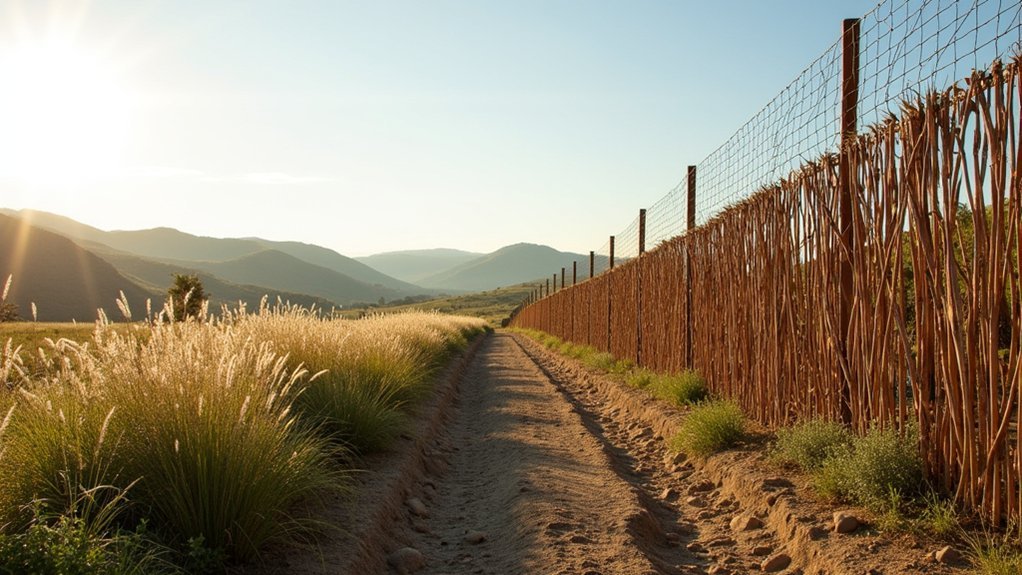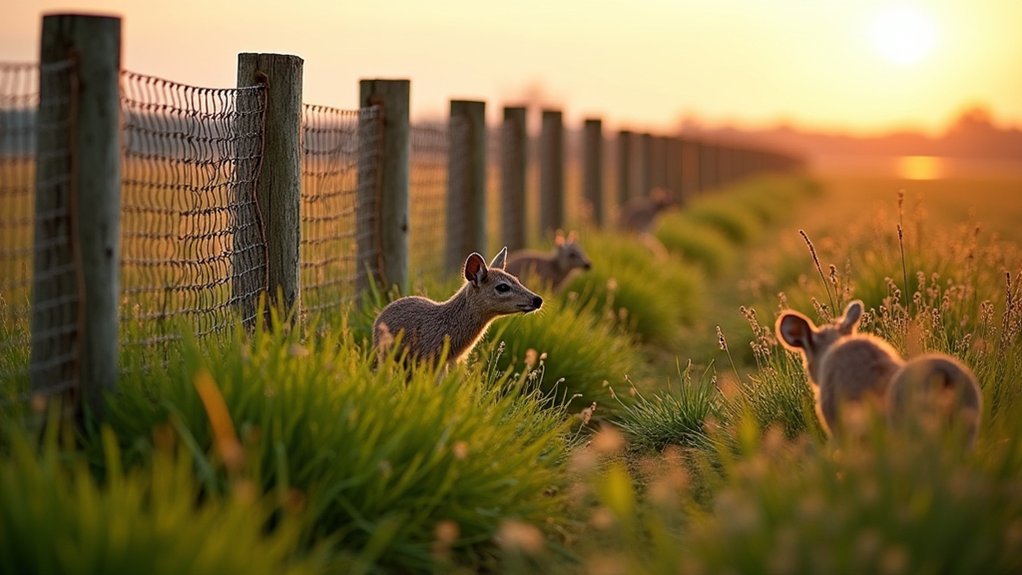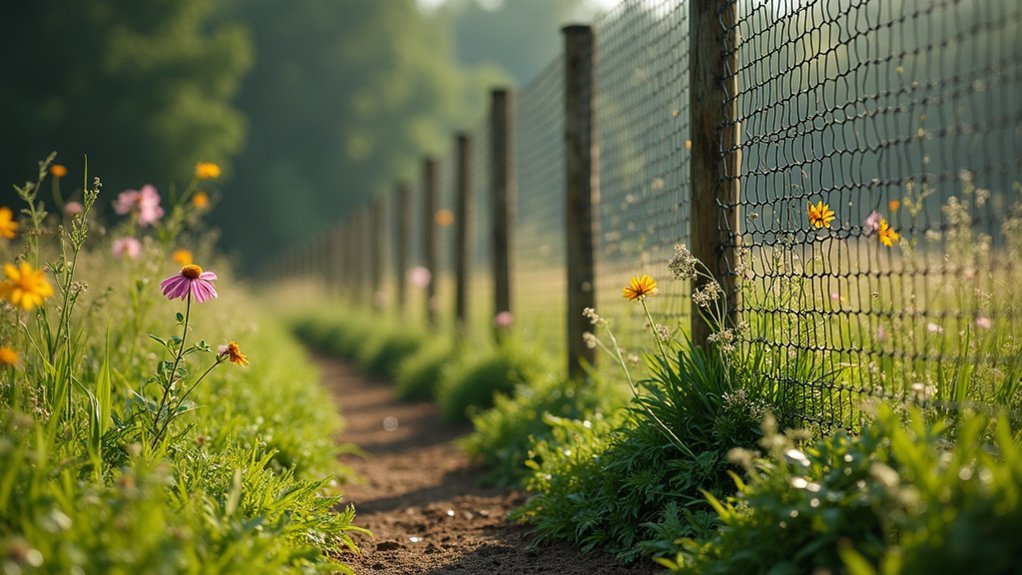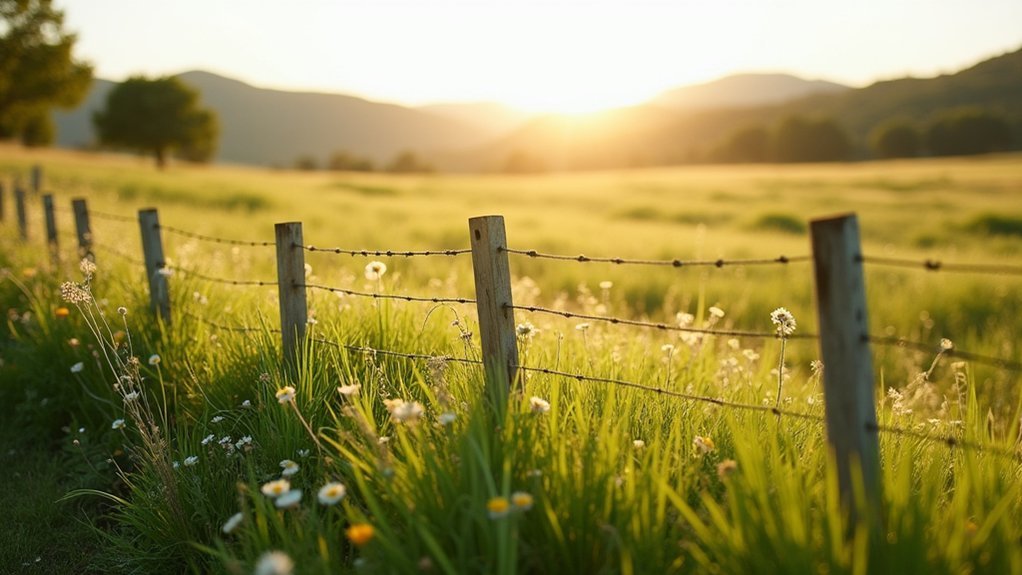Wildlife-friendly climate fencing combines permeable designs with native vegetation to create resilient barriers that protect crops while allowing animal movement. You’ll benefit from electrified porcupine fencing that deters larger animals yet permits smaller wildlife to pass through strategic gaps. Integrate seasonal adaptations and monitoring technologies like remote cameras to assess effectiveness across changing conditions. This approach reduces human-wildlife conflict while strengthening local economies and conservation efforts. The complete strategy offers solutions beyond just keeping animals out.
Understanding Ecological Corridors in a Changing Climate

As climate change reshapes natural landscapes, ecological corridors have become lifelines for wildlife populations like the Khulan that depend on connected habitats for survival.
You’ll find these pathways increasingly essential as they counter habitat fragmentation caused by human development and changing environmental conditions.
Research has identified 64 potential corridors for Khulan, including 13 significant transboundary routes.
Scientists have mapped 64 vital pathways for Khulan survival, with 13 crossing international borders.
These connections are particularly important considering that protected areas currently shelter only 16.81% of suitable Khulan habitats—a percentage projected to shrink to between 9.56% and 12.68% under future climate scenarios.
When you establish these corridors strategically, you’re not just addressing today’s conservation challenges; you’re creating adaptive pathways that respond to shifting temperature patterns and water availability, which strongly influence where Khulan can thrive.
Biodiversity Benefits of Permeable Boundary Systems
When traditional barriers give way to thoughtfully designed permeable fencing, biodiversity flourishes across previously fragmented landscapes. You’ll see improved habitat connectivity as small and medium mammals pass freely through these systems, maintaining essential ecological relationships.
| Species Benefits | Ecosystem Impact | Implementation Context |
|---|---|---|
| Enhanced genetic diversity | Healthier ecosystems | Solar energy developments |
| Increased wildlife movement | Climate change adaptation | Agricultural boundaries |
| Reduced displacement | Prevention of isolation | Conservation corridors |
| Human-wildlife conflict reduction | Economic benefits | Fragmented landscapes |
Designing for Wildlife Movement and Thermal Regulation

You’ll need permeable fencing designs that accommodate various wildlife sizes, allowing smaller mammals to pass through while still managing larger species’ movements.
Consider how your fencing materials and configurations create thermal microclimates that can provide essential refuges during temperature extremes.
Incorporating native vegetation alongside fencing not only enhances these thermal regulation benefits but also offers valuable cover and food resources for diverse wildlife populations.
Permeable Barrier Designs
Innovative permeable barrier designs have revolutionized the concept of climate fencing by prioritizing both wildlife mobility and thermal regulation.
You’ll find these designs incorporate strategic gaps and openings that allow small-to-medium mammals to travel freely through landscapes that would otherwise fragment their habitats.
When you implement permeable fencing, you’re directly enhancing habitat connectivity while addressing thermal challenges wildlife face in changing climates.
These fences provide natural ventilation that reduces heat buildup, creating safer passage corridors. They’re particularly effective at balancing agricultural protection with ecological needs—deterring larger species from croplands while enabling smaller wildlife to maintain their movement patterns.
For best results, you should encourage collaboration between ecologists and land developers to design barriers that reduce genetic isolation while respecting practical land management requirements.
Temperature Gradient Considerations
Although often overlooked in traditional barrier designs, temperature gradients play a critical role in wildlife-friendly climate fencing. When you’re designing these structures, you must account for how varying thermal conditions affect species like the Khulan in desert steppe ecosystems.
Wildlife-friendly fencing should incorporate materials that allow animals to regulate their body temperature by accessing cooler microhabitats during extreme heat.
Studies project a 30% decline in suitable habitats due to habitat fragmentation under future climate scenarios. By implementing permeable barriers that work with temperature gradients, you’ll enable wildlife to move between core habitats as they seek thermal relief.
Your fencing solutions should prioritize connectivity that supports species survival amid changing climate conditions, ensuring animals can find refuge from heat stress while maintaining their natural movement patterns.
Native Plant Integration for Resilient Living Barriers
While traditional fencing solutions focus primarily on creating physical barriers, integrating native plants transforms wildlife-friendly climate fencing into living ecosystems that serve multiple purposes. You’ll create habitat corridors that counter habitat loss while maintaining boundary control.
Native species provide food, shelter, and movement pathways that rigid structures alone cannot offer. Your wildlife-friendly fence becomes more effective when supplemented with strategic vegetation.
| Plant Type | Benefits | Maintenance |
|---|---|---|
| Wildflowers | Pollinator support | Annual reseeding |
| Shrubs | Small wildlife shelter | Minimal pruning |
| Grasses | Erosion control | Adjusted mowing schedule |
| Vines | Fence coverage | Seasonal training |
Monitoring Technologies for Wildlife Interaction Assessment

You’ll find remote sensing applications particularly valuable for tracking wildlife movements across large solar installations without disturbing natural behaviors.
Motion-triggered cameras strategically placed along fencing perimeters capture essential data on how species interact with barriers and utilize wildlife corridors.
Acoustic monitoring systems complement visual data by detecting vocalizations of nocturnal or elusive species that might otherwise go unnoticed during traditional observation periods.
Remote Sensing Applications
As climate fencing installations expand across wildlife habitats, remote sensing technologies have emerged as essential tools for monitoring animal interactions with these structures.
You’ll find high-resolution satellite imagery and aerial drones particularly valuable for evaluating habitat fragmentation and identifying potential wildlife crossings that maintain connectivity around fencing systems.
Thermal imaging cameras detect wildlife presence at fencing sites, allowing you to gauge the effectiveness of different designs in facilitating safe passage.
By integrating GIS analysis tools with remote sensing data, you can map animal movement patterns and quantify the impact of fencing on species like Khulan.
This combined approach strengthens your field studies, creating an all-encompassing understanding of how wildlife responds to barriers and enabling you to implement adaptive management practices that respect ecological needs.
Motion-Triggered Camera Integration
Motion-triggered cameras have revolutionized wildlife monitoring around climate fencing installations, offering unprecedented insights into animal behavior patterns.
These camera traps provide critical data on how species like bobcats interact with solar facilities, helping you track their movements and responses to infrastructure.
You’ll find that effective camera placement helps evaluate wildlife passageway functionality by documenting which animals successfully navigate around fencing.
However, interpretation requires caution—an animal’s presence doesn’t automatically indicate positive habitat use.
When developing wildlife-friendly solar installations, your conservation strategies should incorporate these monitoring technologies to balance energy production with habitat protection.
The complex data gathered from motion-triggered cameras informs better design choices, ensuring solar developments accommodate wildlife movement while achieving clean energy goals.
Acoustic Monitoring Systems
Three key innovations in acoustic monitoring technology are transforming how we assess wildlife interactions with climate fencing installations.
You’ll find these systems capture frequencies beyond human hearing, revealing how animals navigate through fragmented habitats while providing data that camera traps alone miss.
- Advanced sensors paired with machine learning algorithms identify species-specific calls, enabling real-time tracking of wildlife movements near fence boundaries.
- Integrated acoustic-visual monitoring networks provide thorough analysis of how animals communicate and behave when encountering fencing structures.
- Continuous sound recording helps identify critical wildlife corridors where fence modifications may be necessary.
Case Studies: Successful Implementations Across Biomes

Examining successful wildlife-friendly climate fencing across diverse ecosystems reveals adaptable solutions that balance conservation with human needs.
The 10% Fence Plan in Kamungi Conservancy demonstrates this perfectly—by fencing just 10% of properties, communities prevent elephant damage while maintaining 90% of land accessible to wildlife and livestock.
Strategic partial fencing creates win-win scenarios where communities thrive alongside wildlife, not in spite of it.
For migratory species like the Khulan, conservation efforts focus on preserving ecological corridors across borders to combat habitat fragmentation accelerated by climate change.
With 64 potential pathways identified, these corridors provide essential movement routes across existing barriers.
You’ll find these approaches are enhanced through integrated training in climate-smart agriculture and permaculture, creating a multi-faceted strategy.
This holistic method has benefited over 110 people, preserved 800 acres for wildlife, and greatly reduced human-wildlife conflict while improving food security.
Balancing Security Needs With Ecological Connectivity
You can implement permeable border solutions that maintain security while allowing wildlife movement through strategically designed gaps and crossings.
Security concerns don’t have to result in habitat fragmentation when you incorporate wildlife-friendly design elements like electrified porcupine fencing that deters larger animals while permitting smaller species to pass.
Thoughtful crossing opportunity design, such as the approaches used in the Kamungi Conservancy’s 10% Fence Plan, enables you to protect cultivated areas while preserving ecological corridors essential for species adaptation to climate change.
Permeable Border Solutions
While traditional barriers effectively restrict human movement, they often create ecological dead zones that fragment habitats and disrupt wildlife migration patterns.
You’ll find permeable border solutions offer an intelligent compromise, enabling wildlife movement while addressing security concerns.
Wildlife-friendly fencing designs incorporate strategic openings that:
- Allow passage for small-to-medium mammals while deterring larger animals
- Maintain ecological connectivity essential for species adapting to climate change
- Reduce habitat fragmentation without compromising boundary definition
Security Without Fragmentation
Balancing security needs with ecological connectivity presents a vital challenge that innovative fencing solutions are uniquely positioned to address.
You’ll find wildlife-friendly fencing options like electrified porcupine designs effectively deter elephants while allowing smaller species to move freely through the landscape.
The 10% Fence Plan exemplifies this balance perfectly—protecting crops and livestock with minimal coverage while keeping 90% of land accessible for wildlife.
By strategically incorporating passageways into your fencing design, you’ll maintain essential ecological connectivity while still securing vulnerable areas.
Success depends on identifying and preserving ecological corridors—natural highways that wildlife depend on for seasonal migration and resource access.
Through transparent community engagement, you can develop fencing strategies that simultaneously address security concerns and prevent habitat fragmentation, creating sustainable coexistence between human and wildlife populations.
Crossing Opportunity Design
Three essential principles guide effective crossing opportunity design in climate fencing: permeability, strategic placement, and species-specific considerations.
When you’re implementing wildlife-friendly fencing, you’ll need to balance security requirements with ecological connectivity to create successful crossing structures.
- Design permeable barriers that allow small-to-medium mammals to traverse while maintaining the fence’s primary function.
- Install crossing structures at wildlife movement corridors identified through monitoring data and habitat assessment.
- Adapt dimensions and features to accommodate target species’ physical capabilities and behavioral patterns.
Climate-Resilient Materials and Construction Techniques
As climate patterns shift unpredictably worldwide, the materials and construction techniques used in wildlife-friendly fencing must evolve accordingly.
You’ll find that electrified porcupine fences represent a breakthrough in climate-resilient solutions, achieving 100% effectiveness in deterring elephants while allowing smaller wildlife to pass through.
Adaptable fencing designs incorporating permeable elements maintain essential wildlife connectivity across increasingly fragmented landscapes, preserving biodiversity even as habitats change.
By integrating natural vegetation like wildflowers and native plants into your fencing, you’re creating ecological corridors that enhance biodiversity.
Consider investing in modular, interchangeable fencing components that reduce costs while increasing adaptability to changing climate conditions.
These innovative approaches not only mitigate human-wildlife conflict but support sustainable land management, improving agricultural yields while protecting critical ecosystems.
Seasonal Adaptations and Maintenance Protocols

While climate-resilient materials form the foundation of effective wildlife fencing, seasonal adaptations and consistent maintenance protocols ultimately determine long-term success.
Durable materials matter, but seasonal adjustments and vigilant upkeep ensure wildlife fencing performs when it matters most.
You’ll need to adjust your maintenance schedule to align with local wildlife breeding seasons, minimizing disruptions during critical nesting periods.
- Implement seasonal vegetation management that promotes native plants and wildflowers, enhancing habitat quality for pollinators while maintaining fence integrity.
- Regularly inspect electrified components like porcupine fences to guarantee they continue deterring larger wildlife without presenting hazards.
- Monitor wildlife movement through designated passageways, collecting seasonal data to verify effectiveness and make necessary adjustments.
Collaborative Approaches to Transboundary Conservation
Effective wildlife conservation often transcends political boundaries, demanding strategic partnerships between governments, conservation organizations, and local communities. For species like the Khulan, whose critical habitats span the China-Mongolia border, collaborative transboundary conservation initiatives are vital to combat habitat fragmentation caused by border fences and infrastructure.
You’ll find that implementing adaptive conservation strategies requires coordinated efforts to maintain the 13 identified transboundary corridors that connect core habitats.
With only 16.81% of suitable Khulan habitat currently protected—projected to decline further under climate change—you need to prioritize cross-border cooperation to guarantee these corridors remain functional.
Economic Incentives for Wildlife-Compatible Barrier Adoption
Three compelling economic incentives make wildlife-compatible barriers attractive for communities living alongside critical habitats. When you invest in solutions like electrified porcupine fencing, you’re not just protecting wildlife—you’re securing your livelihood.
- Guaranteed crop protection: Wildlife-friendly fencing shows 100% effectiveness against elephants, immediately boosting agricultural yields and food security.
- Increased community support: Economic benefits from protected farmlands reduce human-wildlife conflicts, strengthening commitment to conservation in protected areas.
- Enhanced land value: The Kamungi Conservancy model demonstrates how securing 76.5 acres for farming while preserving 800 acres for wildlife creates sustainable value for over 110 community members.
Training in climate-smart agriculture further amplifies these benefits, creating a positive feedback loop between conservation and economic prosperity.
Frequently Asked Questions
What Type of Fence Design Is Best for Wildlife?
For wildlife, you’ll want permeable fencing that allows small-to-medium mammals to pass through while using wildlife crossings like underpasses. Electric porcupine designs work well for deterring larger animals without creating complete barriers.
What Is the Best Fence to Keep Wild Animals Out?
For keeping wild animals out, you’ll need electrified porcupine fences for larger wildlife and wildlife-friendly fencing with permeable barriers for smaller species. Your choice depends on which specific animals you’re trying to exclude.
What Is a Wildlife Friendly Fence?
A wildlife-friendly fence allows you to protect your property while minimizing barriers to animal movement. You’ll often see designs with specific heights, visibility features, or gaps that let smaller animals pass through safely.
What Fencing Issues With Wildlife Are There?
You’ll encounter several wildlife fencing issues including habitat fragmentation, restricted migration routes, blocked access to essential resources, injury from entanglement, and genetic isolation. These barriers can disrupt natural behaviors and threaten species survival.
In Summary
You’ve seen how wildlife-friendly climate fencing creates essential corridors while addressing security needs. By integrating native plants, adaptive materials, and monitoring technologies, you’re not just building barriers—you’re fostering biodiversity networks resilient to climate change. As you implement these strategies, you’ll contribute to transboundary conservation efforts. Don’t wait—the economic incentives and ecological benefits make wildlife-compatible solutions a win-win investment for our shared future.





Leave a Reply